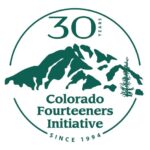These last few months of my summer have been one of the biggest learning experiences in my life. I haven’t ever pushed myself in many of the ways I had to this season. Working with my crew leader Taylor all season, I learned way more about trail work and conservation than I even vaguely expected to (thanks Mom). When applying for this job, my life was not directed anywhere near this path and it wasn’t something I expected to happen. But it took little time to realize what I had gotten into and to find my rhythm and place.
Following the two weeks of training, the season started out on Mt. Yale working on a staircase that is still one of the projects I am most happy to share. Taylor and I spent six days working on a staircase at the beginning on the split for Yale and it was my first real glimpse at CFI’s proudest work, rock work.

Before (June 2017)

After (September 2017)
The following weeks were spent working on Quandary, Belford/Oxford, and Gray’s/Torrey’s with various volunteer groups. While having participated in volunteer work and some other leadership experiences, I hadn’t ever had that much responsibility to teach and keep a group of people as safe as possible. Working with volunteers was the most challenging part of the season, but oftentimes led to incredible work with amazing people. We installed backwall on Quandary and check steps on the Belford/Oxford approach. Our time on Gray’s and Torrey’s was spent building backwall (a retention structure for the upslope side of the trail), clearing the trail of loose rock and debris, and closing some of the many social trails (trails made just by the impact of people hiking through the area, rarely are they sustainable) on Gray’s.
After this, Taylor and I worked most of the rest of the season apart from the rest of the CFI Adopt crews on South Maroon and then down around the Lake City San Juans. On South Maroon, we worked with a duo from Feral Mountain Co. on the start of a fantastic staircase through some willows not far up the trail (that was later continued by our crewmates.)

Before

After
Besides the odd check step or short section of backwall, this was my second major rockwork project. It involved quarrying some massive rocks slowly through a steep talus field, then uphill for a short and narrow section of corridor, and lots of plans changing halfway through. Working on this section taught me a lot about the most effective techniques to use when doing rock work, and how to pivot when the plan changes partway through.
I spent three weeks of August on Uncompahgre, Redcloud/Sunshine, and Handies, far away from the rest of CFI’s field crew members. After completing some restoration work and prepping timber checks with a summer camp, we worked with BLM for a few weeks on a large volunteer project with VOC on Redcloud/Sunshine and then a conservation corps oversight. The volunteer project involved a rerouted section as well as rock checks up higher on the trail.

Grass plugs transplanted on Uncompahgre

Installing crib on Redcloud/Sunshine
Working with the conservation corps and BLM was the longest project that we had with a single group of people. That part made it one of my favorite projects of the season because we were able to develop a strong dynamic with our coworkers, get large projects mapped out, and beautiful completed structures. Near the trailhead on Redcloud/Sunshine around 40 timber checks were installed, while on Handies the corps was able to install around 8 great cribbed rock checks.

A timber check being securely crushed

Some of the completed checks
We spent a week back up around Twin Lakes installing monowall on Mt. Massive before we went back to Uncompahgre for four days with some direct volunteer sign-ups through our website, www.14ers.org. While many of them didn’t have much experience with this kind of work, we had one of the most productive projects of the season that weekend. I worked on a 60-foot section of trail that had been eroding away for some time. It had no structures preventing the continued erosion of the section and a social trail had braided around the difficult section. Through the installation of some plugs and four check steps as well as some basic clean-up, the area was much more desirable for hikers to use the correct trail. More importantly, the trail is now sustainable preventing the continued erosion of the alpine tundra.

Before

After
I am extremely grateful to the Appelson family for funding this internship and CFI for the opportunity I have had this summer. I look forward to coming back!


